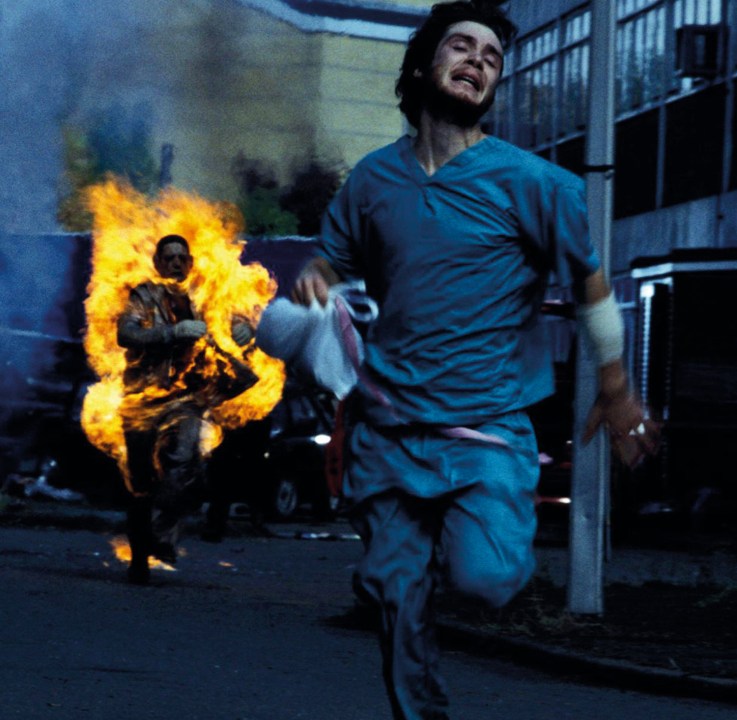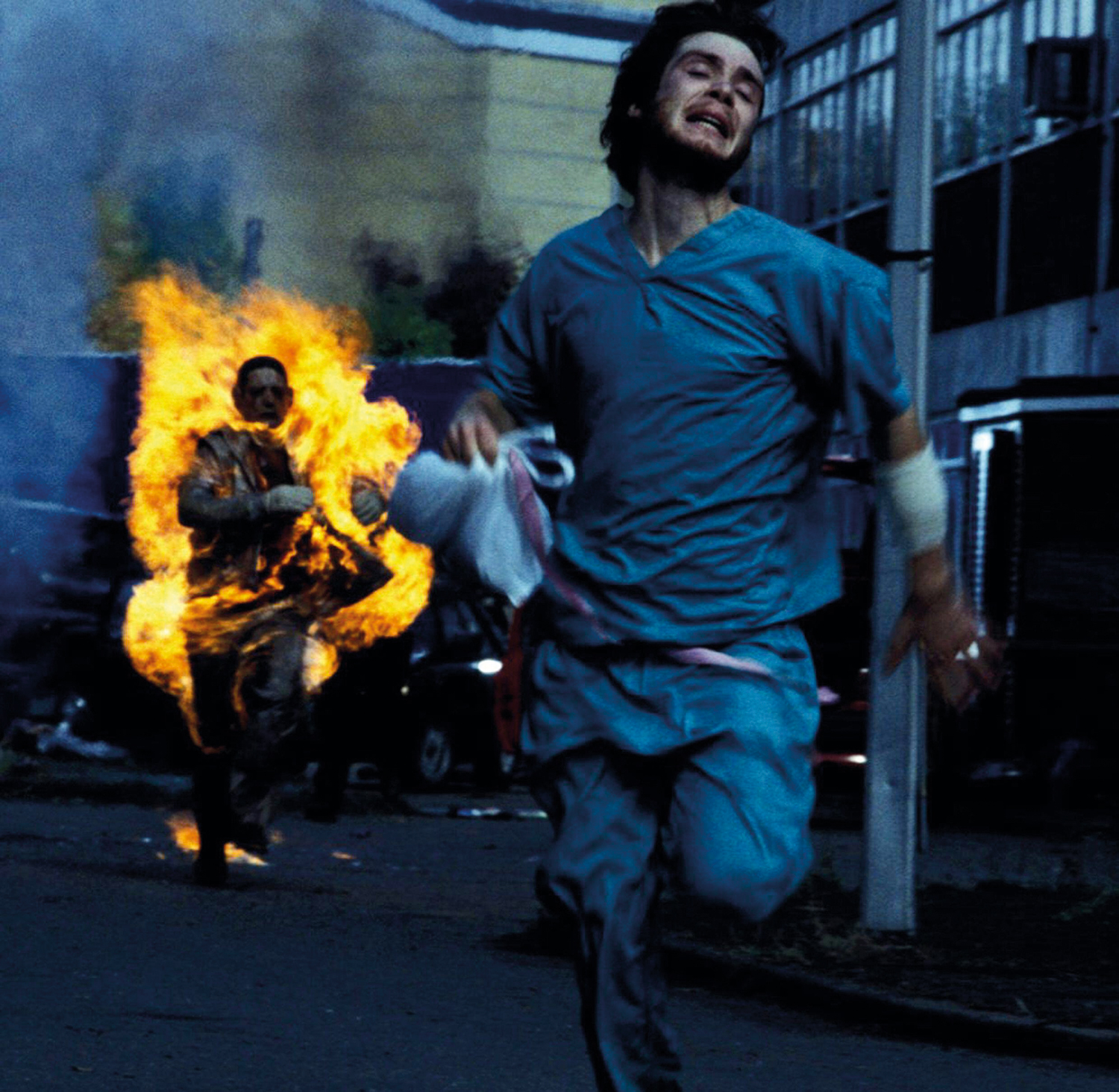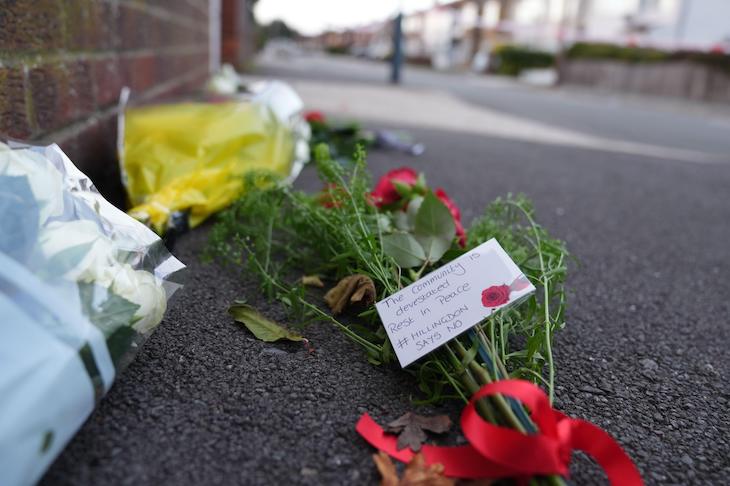
Laurie Penny has narrated this article for you to listen to.
Everyone forgets the actual opening scene of 28 Days Later, even though it’s deeply relatable, in that it features a helpless chimp strapped to a table and forced to watch doomreels of ultraviolence until it loses its little monkey mind and eats David Schneider. But it’s eclipsed by the famous sequence that follows where Cillian Murphy wakes in a hospital bed to find that he has slept through a deadly pandemic and the ensuing collapse of civilisation. As Murphy drags his not-yet-world-famous cheekbones through an eerily abandoned metropolis, we see Piccadilly plastered with the names and faces of the missing and the dead. Audiences in 2002 were reminded of the recent World Trade Centre attacks, which happened in the middle of filming. Unfortunately, it was about to get a lot more prescient.
This week, as the long-awaited last instalment of Alex Garland’s zombie trilogy hits cinemas (reviewed in this issue), it’s worth looking back on the first two films – the second, 28 Weeks Later, premièred in 2007 – which feel like a ‘coming up next’ montage for two decades of economic collapse, climate breakdown, civil unrest, carnage and chaos. There’s the theatre of quarantine, the masked soldiers swabbing holding pens of survivors. There’s Naomie Harris, the original exposition ninja: ‘It started as rioting and right from the beginning you knew this was different. Because it was happening in small villages, market towns, and then it wasn’t on the TV any more, it was on the street outside… By the time they tried to evacuate the cities it was already too late. The infection was everywhere.’
Decent horror does a lot more than scare the audience. It asks us to think about what frightens us, and why. The big three monsters of mass culture are vampires, werewolves and zombies, in descending order of sexiness. I apologise to everyone whose doctoral theses I’m about to comic sansify but, in brief, the big three are essentially ego, id and superego: vampires are about power, exploitation and the nasty suspicion that, given the chance, you, too, might be prepared to hurt other people if it meant getting to flounce about for ever in a mansion. Werewolves are about the monster inside you, about the fear that one day you’ll lose control, tear up your life and wake up in the woods with a weird headache and wearing the wrong trousers. But zombies are the most obviously political. Zombies are all about our fear of other people.
Terror of the unstoppable mob has been baked into the genre from the beginning. In the 1960s, George Romero’s Living Dead franchise caught the mood of the mass protest and played into polite society’s fear of the civil-rights movement. In the intervening decades we’ve been served every flavour of shambling undead, and all of them, even Resident Evil, offer us what looks like a reassuringly simple moral choice. The horde has ceased to be sentient and cannot be reasoned with; there is no way to have a productive debate with someone who actively is trying to chew out your pituitary gland. Which is upsettingly relevant to the recent experience of representative democracy.
Decent horror does more than scare us. It asks what frightens us, and why
Garland’s ravenous, man-eating mobs of ‘infected’ are not, technically, undead – they’re just very, very cross. The virus spreading unstoppably across the nation is, simply, ‘rage’. If you’d pitched that in 2020, it might have felt too on the nose, but Garland has already explicitly told us 28 Years Later is more about Brexit than it is about Covid. Zombie movies aren’t just about fear of the mob – they’re also about the horror of having to tolerate other people. They’re about the price we pay for the notional protections of civilisation, and they’re rarely subtle about it, which is fine, because nobody watches monster movies for delicate analogy, and personally I prefer my Hobbesian dilemmas served up with dishy actors dressed mainly in other people’s blood panting, screaming and swinging baseball bats.
‘Are we the baddies?’ is hardly an original thought, but the question will remain relevant until western society comes up with an answer. In the final act of 28 Days Later, it turns out that there are more frightening things than the mindless mob: there is power wielded with ruthless efficiency. There’s the cold logic of institutional violence, made flesh in Major Henry West, played with appalling composure by Christopher Eccleston, who shelters our heroes in the apparent safety of his military compound. But West has a problem: his men are despairing, because they have the means of survival, but nothing to hope for. Without women, he explains, there is no future. West’s simple solution is to kidnap women and forcibly breed them in exchange for protection from the mob, and while going right to institutional gang-rape might have seemed like a wild escalation in 2002, these days he would be just one YouTube ethno-fascist among many.
I suspect we’ll be coming back to this theme in the final film, purely on the basis of the trailers, where a suspiciously monochromatic crowd of survivors seems to be doing some sketchy religion on Lindisfarne. Alex Garland is famously genre-queer – skipping provocatively from big-budget disaster movies to contemporary tech thrillers to murder mysteries in space – but he has certain predictable tropes. Something disgusting will always happen to a priest. Someone will be overwhelmed by the implications of technology and have an existential breakdown. There will be a scene full of bristling symbolism, where someone will run through a forest while a hypnotic soft-metal soundtrack plays. A bloviating, overpowered alpha-male type will play god; a brave lady with an edgy short haircut will try to stop him; and a sensitive young man will have to pick a side.
Over and over again, in action and science fiction and folk horror, Garland grapples with how men are meant to make women love and serve them. It’s the driving issue of Ex Machina and of Men, the 2022 low-budget surrealist horror where Jessie Buckley gets hunted through the woods by far too many Rory Kinnears. And over the course of the century the question has become far less academic.
In this age of universal catastrophism, where we all at least get to choose our own apocalypse, some people are far less troubled by plague, famine or financial meltdown than they are by the collapse of certain social norms. Immigration. The active presence of gay and transgender people trampling all over our tidy traditions. And women who don’t need men.
I was 14 when I watched the final, controversial scenes of 28 Days Later, where the women in Murphy’s party are stripped and prepped for their first session with the lads. For these soldiers, women’s agency is a luxury that a post-collapse world cannot afford – along with cappuccinos and subtle analogy. A surprising number of new-right doomsayers are anticipating the fall of civilisation on that very basis. The logic of the manosphere teaches us that when the dung hits the Dyson, society will revert to a natural order where men are real men, women are grateful, and most problems can be solved by shooting at them.
But the world only works like that in the movies. In fact, as we learned in the Covid years, an actual collective crisis doesn’t call for tough guys who shoot first and ask questions never. The real heroes are doctors, nurses and first responders, and when things fall apart, people don’t just start eating each other. They start feeding each other.
28 Years Later, which is reviewed in this issue, is out now.








Comments